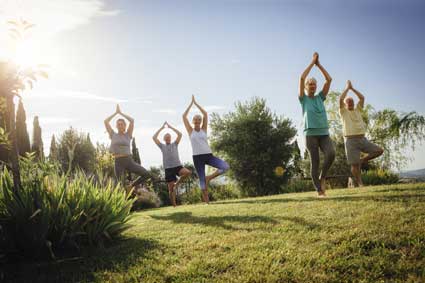???
What makes yoga different from other stretching and fitness exercises?
Yoga is not a sport but the art and science of mental, physical, and spiritual development. For example, the physical aspect of yoga is unique from other exercises because it connects the body movements and fluctuations of our intellect to the rhythm of our breathing. The postures are intended to help prepare the body for mental and spiritual growth, and flexibility. Connecting the mind, body, and breath helps us focus our attention toward the inner self. Not only will your body become more flexible, but the mind also becomes more willing.
Yoga is only for women.
In parts of the world, the majority of those practicing yoga are women. Some men may have the idea that yoga is not for them. But all people, no matter what gender, are searching for inner peace, wanting to avoid disease, and desiring good health. Yoga treats yogi (male) and (female) alike.
What is a mantra?
A mantra is an "Om" or vibration customarily chanted at the beginning or end of yoga exercises. Scientists today are confirming what yogis already knew: that the entire universe is in motion. Everything that exists has a rhythm of its own. The ancient yogis acknowledged this as the sound of "Om." The sound is in the rustling of the wind, the chirping of the crickets, and the shush of waves rolling over sand. As we chant "Om," our breath, awareness, and energy takes us on a universal journey that is elevating and calming.
Must everyone practice the same postures?
In yoga classes worldwide you will find several people at once practicing the same postures. However, the needs of individuals vary according to their physical and spiritual requirements, and it's best to practice those postures suited to that particular individual. An elderly woman with arthritis may need postures different from a young man who has multiple sclerosis. There is also a matter of preference involved. Certain postures make you feel "better" than others, which is the intent of yoga.
How many times per week must I practice?
Even if you practice only once a week, you will experience a change. The more you do, the greater the experience. Two or three times a week for 30 minutes at a time is a good start. You can extend your time as you see fit. A once-a-week yoga class and two sessions at home is ideal. Don't beat yourself up over unrealistic goals or time constraints. After a while, you'll find yourself wanting to expand your practice time, setting priorities and making sure yoga is one of them.
Can I burn incense while practicing yoga?
Because yoga should be performed in a clean, well-lit, smoke free area, it's not a good idea to burn incense. The smoke from burning incense can cause a barrier during meditation and hinder you from going within. It can be burned prior to meditation or postures, but avoid smoke when you begin. A nice touch is to burn unscented, preferably white candles. Set up your own special corner to fit your mat, a folding chair, and a small table for your candle, yoga bell, or whatever gets you into the holistic spirit of yoga.
Do I have to give up meat to practice yoga?
The main belief of yoga philosophy is ahimsa meaning not harming self or others. Certain people deduce this to mean not eating animal products. The yoga community is still debating over this. I believe this to be a judgment decision that you must decide yourself. People who eat meat are not bad people. I still eat an occasional steak or hamburger. If you are thinking about becoming a vegetarian (no meat), a vegan, or an advocate of eating foods that require no cooking, check it out with a health provider or dietitian. If you have small children, be mindful that they need certain foods for growth and health.
What does Hatha really mean?
Hatha Yoga refers to asanas or postures (physical exercises) and successions of asanas calculated to align your bones, muscles, and skin. The word "Hatha" means willful or forceful. The postures are designed to open the channels of the body, focusing on the main channel, which is the spine, so energy can stream without hindrance
Hatha is also translated as Ha -- meaning sun and tha -- meaning moon. This refers to the masculine side or active, hot sun and the feminine side as a receptive, cool moon -- both sides in all of us. Hatha yoga is a journey toward a physical balance of strength and flexibility. Each pose helps us to balance our efforts toward that goal. Hatha asks us to bring our attention on our breathing to still and level the mind and be more in the present. I am.
Do I have to be flexible to perform yoga?
Certain yoga postures are somewhat difficult and require an agile body. Postures should be selected according to the ailments of each person's body. When taking a yoga class, a competent instructor will demonstrate and assign postures that are within your limits. Don't worry about looking like that perfectly aligned person beside you. Just do them to the best of your capabilities and allow your instructor to make subtle corrections to gain the most from your pose. Every little bit you do counts toward self connection.
It's good to practice yoga outdoors, but not when it is cold or drafty. When you perform poses correctly, your body becomes sensitive to temperature shifts. If you find yourself becoming cold, you should take your yoga indoors. My two friends and I would go down to the pier leading out to Lake Tahoe and practice our poses. It was the best yoga memory I have, since one of those friends is now a cancer survivor. Make every yoga session a worthwhile memory.
Do I need special equipment to perform yoga?
Actually, all you really need to practice yoga is your mind and body. It helps to have some sweat pants, a nice fitting t-shirt (not oversized), and a light blanket. If you perspire heavily, you may want to bring a towel. Your own mat may be important if you practice yoga at home. Most studios will have props available. Keep sanitary wipes available to clean your own and borrowed mats. They pick up dirt from the floor.
Why do I need to refrain from eating two/three hours before class or doing postures?
During yoga practice, you turn and twist, pose upside down, and bend forward and backward. If your last meal is not completely digested, it will make itself known to you in some unpleasant ways. If you digest your meals quickly, and are afraid you might be hungry or weak during yoga, have a glass of milk or a small container of yogurt 30 minutes prior to class.
I always thought the physical postures of yoga the most important.
Although many people do feel this way, they are not the most important aspect of yoga. The ancient system of yoga considers the understanding and practice of moral principles and living a life in accord with self and others the most important. Yoga's foundation rests on observing principles such as not harming others, acting to assist other's welfare, not stealing, not accumulating excessive physical wealth, purity of mind, contentment, and selfless service to others.
The idea is to live life in harmony with others around you, while working on your own inner development. When this is done, the breathing, postures and meditation can be practiced with the utmost effect.
Namaste ~





























